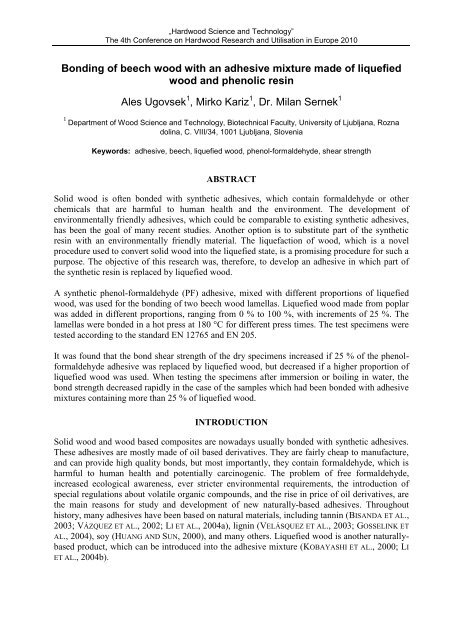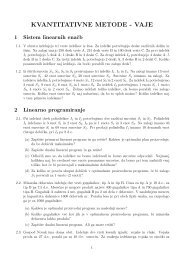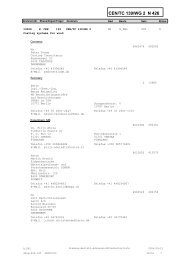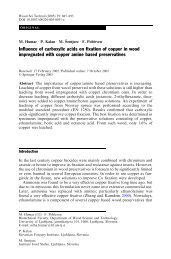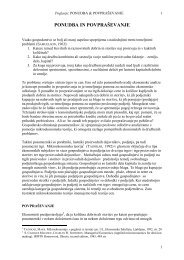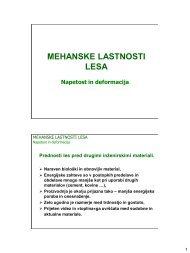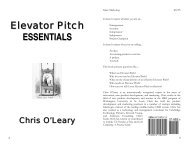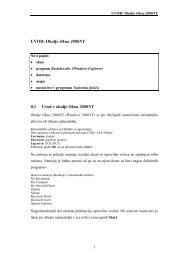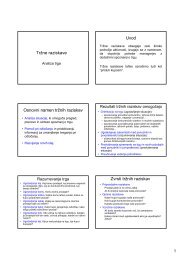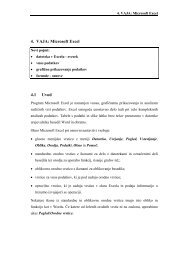Title of paper (Use 14 pt Arial bold)
Title of paper (Use 14 pt Arial bold)
Title of paper (Use 14 pt Arial bold)
- No tags were found...
You also want an ePaper? Increase the reach of your titles
YUMPU automatically turns print PDFs into web optimized ePapers that Google loves.
„Hardwood Science and Technology”The 4th Conference on Hardwood Research and Utilisation in Europe 2010Bonding <strong>of</strong> beech wood with an adhesive mixture made <strong>of</strong> liquefiedwood and phenolic resinAles Ugovsek 1 , Mirko Kariz 1 , Dr. Milan Sernek 11 Department <strong>of</strong> Wood Science and Technology, Biotechnical Faculty, University <strong>of</strong> Ljubljana, Roznadolina, C. VIII/34, 1001 Ljubljana, SloveniaKeywords: adhesive, beech, liquefied wood, phenol-formaldehyde, shear strengthABSTRACTSolid wood is <strong>of</strong>ten bonded with synthetic adhesives, which contain formaldehyde or otherchemicals that are harmful to human health and the environment. The development <strong>of</strong>environmentally friendly adhesives, which could be comparable to existing synthetic adhesives,has been the goal <strong>of</strong> many recent studies. Another o<strong>pt</strong>ion is to substitute part <strong>of</strong> the syntheticresin with an environmentally friendly material. The liquefaction <strong>of</strong> wood, which is a novelprocedure used to convert solid wood into the liquefied state, is a promising procedure for such apurpose. The objective <strong>of</strong> this research was, therefore, to develop an adhesive in which part <strong>of</strong>the synthetic resin is replaced by liquefied wood.A synthetic phenol-formaldehyde (PF) adhesive, mixed with different proportions <strong>of</strong> liquefiedwood, was used for the bonding <strong>of</strong> two beech wood lamellas. Liquefied wood made from poplarwas added in different proportions, ranging from 0 % to 100 %, with increments <strong>of</strong> 25 %. Thelamellas were bonded in a hot press at 180 °C for different press times. The test specimens weretested according to the standard EN 12765 and EN 205.It was found that the bond shear strength <strong>of</strong> the dry specimens increased if 25 % <strong>of</strong> the phenolformaldehydeadhesive was replaced by liquefied wood, but decreased if a higher proportion <strong>of</strong>liquefied wood was used. When testing the specimens after immersion or boiling in water, thebond strength decreased rapidly in the case <strong>of</strong> the samples which had been bonded with adhesivemixtures containing more than 25 % <strong>of</strong> liquefied wood.INTRODUCTIONSolid wood and wood based composites are nowadays usually bonded with synthetic adhesives.These adhesives are mostly made <strong>of</strong> oil based derivatives. They are fairly cheap to manufacture,and can provide high quality bonds, but most importantly, they contain formaldehyde, which isharmful to human health and potentially carcinogenic. The problem <strong>of</strong> free formaldehyde,increased ecological awareness, ever stricter environmental requirements, the introduction <strong>of</strong>special regulations about volatile organic compounds, and the rise in price <strong>of</strong> oil derivatives, arethe main reasons for study and development <strong>of</strong> new naturally-based adhesives. Throughouthistory, many adhesives have been based on natural materials, including tannin (BISANDA ET AL.,2003; VÁZQUEZ ET AL., 2002; LI ET AL., 2004a), lignin (VELÁSQUEZ ET AL., 2003; GOSSELINK ETAL., 2004), soy (HUANG AND SUN, 2000), and many others. Liquefied wood is another naturallybasedproduct, which can be introduced into the adhesive mixture (KOBAYASHI ET AL., 2000; LIET AL., 2004b).
„Hardwood Science and Technology”The 4th Conference on Hardwood Research and Utilisation in Europe 2010Solid wood can be liquefied using different solvent systems. The first system uses phenols(ALMA AND BASTÜRK, 2006), whereas the second employs cyclic carbonates (XIE AND CHEN,2005), the third uses ionic liquids (HONGLU AND TIEJUN, 2006), the fourth introduces dibasicesters without hydroxyl groups (WEI ET AL., 2004), and the fifth system is based on polyhydricalcohols. Solid wood liquefied with polyhydric alcohols contains enough -OH groups, which canpotentially react with the PF resin, and take part in the adhesive mixture as a copolymer (BUDIJAET AL., 2009). The objective <strong>of</strong> this study was to determine the bond performance <strong>of</strong> specimensfrom beech wood bonded with an adhesive mixture made <strong>of</strong> liquefied wood and phenolic resin.EXPERIMENTAL METHODSSawdust (fractions 0,237 mm or smaller) <strong>of</strong> the black poplar (Populus nigra L.) was used for theproduction <strong>of</strong> liquefied wood (LW). Prior to the liquefaction process, the sawdust was dried in alaboratory oven (103 °C, 24 h). Glycerol (GLY) (p.a. grade, Kemika, Croatia) was used as thereaction reagent, and sulphuric acid (SA) (p.a. grade, Sigma Aldrich, Germany) was used as acatalyst. The mass ratio between the black poplar sawdust and the GLY was 1:3 (150 g <strong>of</strong>sawdust and 450 g <strong>of</strong> GLY), and 3 % <strong>of</strong> SA, based on the GLY content, was added (13,5 g). Theliquefaction reaction was performed for 90 minutes in a glass laboratory reactor, which wasimmersed in an oil bath that had been preheated to 180 °C. After reaction, the reactor wasimmersed in cold water in order to quench the reaction. The liquefied product was then dilutedwith a mixture <strong>of</strong> 1,4-dioxane and water (4/1, v/v) and filtered through filter disks (Sartoriusfilter disks 388 grade/84/mm 2 ) to remove the insoluble parts <strong>of</strong> the wood. After filtration, themixture <strong>of</strong> 1,4-dioxane and water was evaporated under reduced pressure, obtained by using awater pump, in order to obtain the liquefied wood containing GLY.The adhesive mixtures were prepared according to Table 1. A commercially available syntheticPF adhesive (Fenolit d.d., Slovenia) was used to prepare the different PF-LW adhesive mixtures.Table 1: Preparation <strong>of</strong> the adhesive mixturesAdhesive mixture Weight portion <strong>of</strong> PF adhesive [%] Weight portion <strong>of</strong> LW [%]1 100 02 75 253 50 504 25 755 0 100Prior to bonding, all <strong>of</strong> the beech wood lamellas were planed in order to ensure a smooth and flatsurface. The two lamellas were then bonded together with the different adhesive mixtures (Table1). The adhesive mixtures were applied with a roller, using an application rate <strong>of</strong> 200 g/m 2 . Thepress temperature was 180 °C, and the pressure was 1 MPa. In the first part <strong>of</strong> experiment thepress time was 600 seconds for all the adhesive mixtures, whereas in the second part the presstime was ada<strong>pt</strong>ed to the used adhesive mixtures (Table 2). The press times used in the secondpart <strong>of</strong> the experiment were determined on the basis <strong>of</strong> preliminary rheological measurements <strong>of</strong>the adhesive mixtures.
„Hardwood Science and Technology”The 4th Conference on Hardwood Research and Utilisation in Europe 2010Table 2: Press times with different adhesive mixturesAdhesive mixture Press time-first part [s] Press time-second part [s]1 600 6002 600 6603 600 7204 600 12005 600 2400The PF-LW adhesive mixtures were tested according to the standard SIST EN 12765:2002. Thebonded samples were cut into specimens according to standard SIST EN 205. The specimenswere then conditioned for 1 week in a standard climate. The dimensions <strong>of</strong> the shear areas weremeasured for all the specimens. Specimens from each press time group were divided into foursubgroups for the different pre-treatments, prior to testing according to the standard SIST EN12765:2002. The first subgroup <strong>of</strong> specimens (pre-treatment 1) was tested in the dry state afterconditioning in a standard climate; the second subgroup <strong>of</strong> specimens (pre-treatment 2) wassoaked in cold water (20±5 °C) for 24 hours; the third subgroup <strong>of</strong> specimens (pre-treatment 3)was soaked in hot water (67±3 °C) for 3 hours, and then cooled in cold water for 2 hours; and thefourth subgroup <strong>of</strong> specimens (pre-treatment 4) was boiled for 3 hours, and cooled in cold waterfor 2 hours. The shear tests were carried out on a ZWICK/Z100 universal testing machineaccording to standard SIST EN 205, immediately after the pre-treatments had been performed.RESULTS AND DISCUSSIONThe shear strength values <strong>of</strong> the tested specimens bonded with different adhesive mixtures,tested after different pre-treatments and a press time 600 seconds, are shown in Table 3. Thewood failure <strong>of</strong> these specimens is shown in Table 4. The specimens bonded with adhesivemixture 2 (25 % <strong>of</strong> LW, 75 % <strong>of</strong> PF) exhibited higher shear strength than the specimens bondedwith the commercial PF adhesive after pre-treatment 1. All the other adhesive mixtures exhibiteda lower shear strength than that <strong>of</strong> the commercial adhesive. After pre-treatments 2, 3 and 4, onlythe test specimens bonded with adhesive mixture 2 exhibited comparable values to thecommercial PF adhesive. All the other values were much lower, and did not attain therequirements <strong>of</strong> the standard. According to the standard SIST EN 12765:2002, only thecommercial synthetic PF adhesive and the adhesive mixture with 25 % <strong>of</strong> added LW to the PFadhesive met the requirements for C1, C2 and C3 durability classes, whereas for the C4durability class only the PF adhesive was suitable.Table 3: Shear strength [N/mm 2 ] <strong>of</strong> the tested specimens after different pre-treatments and a press time <strong>of</strong> 600secondsAdhesive mixture Pretreatment 1 Pretreatment 2 Pretreatment 3 Pretreatment 41 11,92 7,89 7,64 7,542 13,5 7,58 7,18 6,963 9,61 4 0 04 7,38 1,72 0 05 0,56 0 0 0
„Hardwood Science and Technology”The 4th Conference on Hardwood Research and Utilisation in Europe 2010Table 4: Wood failure [%] <strong>of</strong> the tested specimens after different pre-treatments and a press time <strong>of</strong> 600 secondsAdhesive mixture Pretreatment 1 Pretreatment 2 Pretreatment 3 Pretreatment 41 80 92 82 732 91 77 62 713 83 5 0 04 9 0 0 05 0 0 0 0The shear strength <strong>of</strong> the specimens bonded with different adhesive mixtures, tested after differentpre-treatments and bonded with different press times, are shown in Table 5. The wood failurevalues <strong>of</strong> these specimens are shown in Table 6. As can be seen from Table 5, the values decreaseddrastically after the different pre-treatments. Different press times affected the shear strength values<strong>of</strong> adhesive mixtures 3 and 4. Due to the longer press times, adhesive mixtures 2, 3 and 4 attainedthe requirements for C1 durability class. All the other values decreased rapidly and did not meet therequirements for any <strong>of</strong> the durability classes according to the standard.Table 5: Shear strength [N/mm2] <strong>of</strong> the tested specimens after different pre-treatments and different press timesAdhesive mixture Press time [s] Pretreatment 1 Pretreatment 2 Pretreatment 3 Pretreatment 42 660 11,32 6,7 6,45 6,133 720 10,1 3,74 1,93 2,744 1200 10,12 5,41 0 05 2400 4,6 0 0 0Table 6: Wood failure [%] <strong>of</strong> the tested specimens after different pre-treatments and different press timesAdhesive mixture Press time [s] Pretreatment 1 Pretreatment 2 Pretreatment 3 Pretreatment 42 660 95 96 90 923 720 48 13 2 34 1200 93 11 0 05 2400 35 0 0 0CONCLUSIONSThe bond performance <strong>of</strong> specimens from beech wood, bonded with an adhesive mixture made<strong>of</strong> liquefied wood and phenolic resin, was investigated. The bond shear strength <strong>of</strong> the dryspecimens increased if 25 % <strong>of</strong> the phenol-formaldehyde adhesive was replaced by liquefiedwood, but decreased if a higher proportion <strong>of</strong> liquefied wood was used. When testing thespecimens after immersion or boiling in water, the bond strength decreased rapidly in the case <strong>of</strong>the samples which had been bonded using adhesive mixtures containing more than 25 % <strong>of</strong>liquefied wood. Longer press times contributed to the shear strength values for adhesivemixtures containing up to 75 % <strong>of</strong> liquefied wood. Up to 75 % <strong>of</strong> phenol-formaldehyde resin canbe replaced to attain the requirements <strong>of</strong> the standard for C1 class, whereas these adhesivemixtures are not suitable for other requirements. Longer press times contribute only in the case<strong>of</strong> adhesive mixtures which are used for interior premises, where the moisture content does notexceed 15 %. It can be concluded that, in the case <strong>of</strong> solid wood to be used for non-structural
„Hardwood Science and Technology”The 4th Conference on Hardwood Research and Utilisation in Europe 2010applications in dry conditions, up to 25 % <strong>of</strong> the synthetic phenol-formaldehyde resin can bereplaced by liquefied wood if satisfactory bonding is to be achieved.ACKNOWLEDGEMENTSThe authors acknowledge the financial support <strong>of</strong> the Slovenian Research Agency, throughProject J4-2177. Special thanks go to undergraduate student Aleš Ciber, for technical support <strong>of</strong>the investigations.
„Hardwood Science and Technology”The 4th Conference on Hardwood Research and Utilisation in Europe 2010REFERENCESALMA, H. M., BASTÜRK, M. A. (2006) Liquefaction <strong>of</strong> grapewine cane (Vitis vinisera L.)waste and its application to phenol-formaldehyde type adhesive. Industrial crops andproducts, 24, 171-176BISANDA, E. T. N., OGOLA, W. O., TESHA, J. V. (2003) Characterisation <strong>of</strong> tannin resin blendsfor particle board application. Cement and Concrete Composites, 25, 593-598BUDIJA, F., TAVZES, Č., ZUPANČIČ-KRALJ, L., PETRIČ, M., (2009) Self-crosslinking and filmformation ability <strong>of</strong> liquefied black poplar. Bioresource Technology, 100, 3316-3323GOSSELINK, R. J. A., SNIJDER, M. H. B., KRANENBARG, A., KEISERS, E. R. P., DE JONG, E.,STIGSSON, L. L. (2004) Characterisation and application <strong>of</strong> NovaFiber lignin. IndustrialCrops and Products, 20, 191-203HONGLU, X., TIEJUN, S. (2006) Wood liquefaction by ionic liquids. Holzforschung, 60, 509-512HUANG, W., SUN, X. S. (2000) Adhesive Properties <strong>of</strong> Soy Proteins Modified by Urea andGuanidine Hydrochloride. Journal <strong>of</strong> American Oil Chemist Society, 77(1), 101-104KOBAYASHI, M., TUKAMOTO, K., TOMITA, B. (2000) Application <strong>of</strong> Liquefied Wood to aNew Resin System-Synthesis and Properties <strong>of</strong> Liquefied Wood/Epoxy Resins.Holzforschung, 54, 93–97LI, G., QIN, T., TOHMURA, S., IKEDA, A. (2004b) Preparation <strong>of</strong> phenol formaldehyde resinfrom phenolated wood. Journal <strong>of</strong> forestry research, 15(3), 211-2<strong>14</strong>LI, K., GENG, X., SIMONSEN, J., KARCHESY, J. (2004a) Novel wood adhesives fromcondensed tannins and polyethylenimine. International Journal <strong>of</strong> Adhesion & Adhesives, 24,327-333VÁZQUEZ, G., GONZÁLEZ-ÁLVAREZ, J., LÓPEZ-SUEVOS, F., ANTORRENA, G. (2002) Rheology<strong>of</strong> tannin-added phenol formaldehyde adhesives for plywood. Holz als Roh-und Werkst<strong>of</strong>f,60, 88-91VELÁSQUEZ, J. A., FERRANDO, F., SALVADÓ, J. (2003) Effects <strong>of</strong> Kraft lignin addition in theproduction <strong>of</strong> binderless fiberboard from steam exploded Miscanthus sinensis. IndustrialCrops and Products, 18, 17-23WEI, Y., CHENG, F., LI, H., YU, J. (2004) Synthesis and properties <strong>of</strong> polyurethane resinsbased on liquefied wood. Journal <strong>of</strong> applied polymer science, 92, 351-356XIE, T., CHEN, F. (2005) Fast liquefaction <strong>of</strong> bagasse in ethylene carbonate and preparation <strong>of</strong>epoxy resin from liquefied product. Journal <strong>of</strong> Applied Polymer Science, 98, 1961-1968


